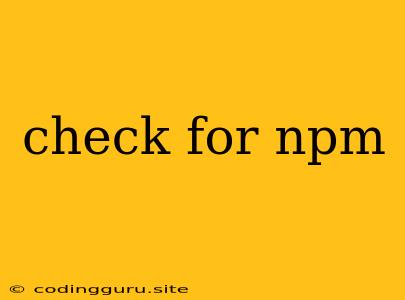What is npm and why do we need to check for it?
npm, which stands for Node Package Manager, is a crucial tool for JavaScript developers. It acts as a central repository for various packages, libraries, and modules that extend the functionality of your JavaScript projects. Think of it as a vast library filled with pre-written code snippets that you can easily incorporate into your projects.
So, why check for npm?
First, it's essential to ensure that you have npm installed on your system. Without it, you won't be able to install, update, or manage any packages for your JavaScript projects. Second, it's important to check for updates to npm itself. New versions of npm often bring bug fixes, performance enhancements, and security improvements. Keeping npm up-to-date is essential for a smooth and efficient development experience.
How to Check if npm is Installed?
The simplest way to verify if npm is installed on your system is by opening your terminal or command prompt and running the following command:
npm --version
This command will print the currently installed version of npm. If npm is not installed, you'll receive an error message.
How to Update npm
To update npm, you can use the npm update -g npm command. The -g flag specifies that you want to update the global version of npm, which means it will be available for all your projects. Here's how you can do it:
- Open your terminal or command prompt.
- Type the following command and press Enter:
npm update -g npm
npm will automatically download and install the latest version.
What If npm is not Installed?
If you find that npm is not installed, you'll need to install it first. The installation process depends on your operating system.
For macOS and Linux users:
- Install Node.js from the official website.
- Node.js comes bundled with npm. Once Node.js is installed, npm will also be available on your system.
For Windows users:
- Download and install the installer from the official website.
- Follow the on-screen instructions during the installation process.
Once the installation is complete, you can verify if npm is installed by running the npm --version command.
Troubleshooting Common Issues
1. Permission Errors: You might encounter permission errors when trying to update or install packages. This usually happens when you lack the necessary permissions to modify system files. Try using sudo (for macOS and Linux) before the npm command to elevate your privileges. For example:
sudo npm update -g npm
2. Network Connectivity Issues: If you're experiencing problems with npm, check your internet connection. Ensure that you're connected to the internet and that your firewall is not blocking npm access.
3. Proxy Server Issues: If you're behind a proxy server, you might need to configure npm to use it. You can set up a proxy using the npm config set proxy command.
4. Package Dependency Conflicts: If you encounter errors during package installation or update, it could be due to conflicts between dependencies. Try cleaning the npm cache using npm cache clean command.
Importance of a Stable npm Environment
A stable and up-to-date npm environment is crucial for any JavaScript developer. It ensures that you have access to the latest packages, libraries, and modules, as well as provides you with the best possible development experience. By checking for npm and updating it regularly, you can avoid potential issues and streamline your development process.
Conclusion
Checking for npm and ensuring it's up-to-date is a critical step for any JavaScript developer. By doing so, you can ensure a smooth and efficient development experience. If you encounter any problems, remember to consult the npm documentation or search online for solutions. With a properly configured and maintained npm environment, you'll be well-equipped to take advantage of the vast and constantly growing JavaScript ecosystem.
